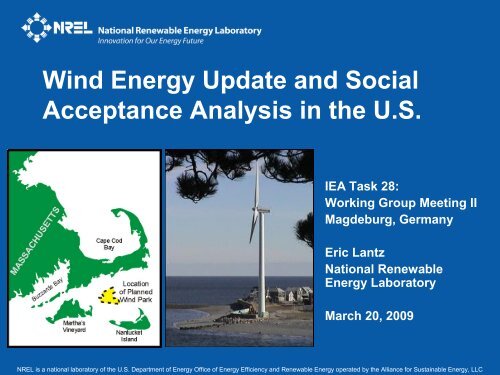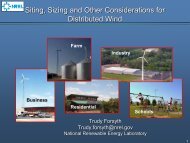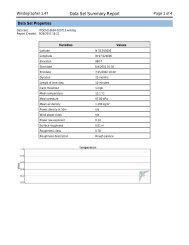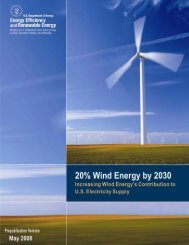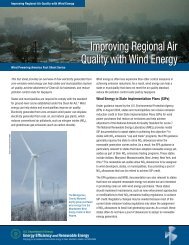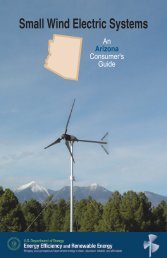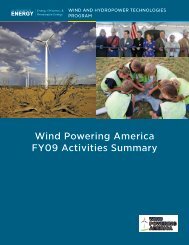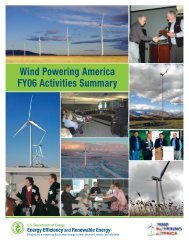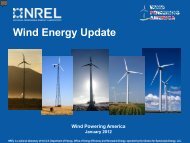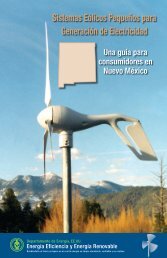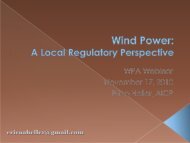Wind Energy Update and Social Acceptance Analysis in the United ...
Wind Energy Update and Social Acceptance Analysis in the United ...
Wind Energy Update and Social Acceptance Analysis in the United ...
You also want an ePaper? Increase the reach of your titles
YUMPU automatically turns print PDFs into web optimized ePapers that Google loves.
<strong>W<strong>in</strong>d</strong> <strong>Energy</strong> <strong>Update</strong> <strong>and</strong> <strong>Social</strong><strong>Acceptance</strong> <strong>Analysis</strong> <strong>in</strong> <strong>the</strong> U.S.IEA Task 28:Work<strong>in</strong>g Group Meet<strong>in</strong>g IIMagdeburg, GermanyEric LantzNational Renewable<strong>Energy</strong> LaboratoryMarch 20, 2009NREL is a national laboratory of <strong>the</strong> U.S. Department of <strong>Energy</strong> Office of <strong>Energy</strong> Efficiency <strong>and</strong> Renewable <strong>Energy</strong> operated by <strong>the</strong> Alliance for Susta<strong>in</strong>able <strong>Energy</strong>, LLC
U.S. <strong>W<strong>in</strong>d</strong> Power Capacity Up 50% <strong>in</strong> 2008Ano<strong>the</strong>r record year for new U.S. w<strong>in</strong>d capacity:8,506 MW of w<strong>in</strong>d added (4,112 MW <strong>in</strong> Q4)Roughly $17 billion <strong>in</strong> <strong>in</strong>vestment
Installed <strong>W<strong>in</strong>d</strong> Capacities (‘99(– 2008)
Additional 2008 Milestones•20% by 2030 Report•Bats <strong>and</strong> <strong>W<strong>in</strong>d</strong> <strong>Energy</strong> Cooperative•American <strong>W<strong>in</strong>d</strong> <strong>and</strong> Wildlife Institute•New political leadership on RE <strong>and</strong>climate• Release of AWEA Sit<strong>in</strong>g H<strong>and</strong>bookNational Renewable <strong>Energy</strong> LaboratoryInnovation for Our <strong>Energy</strong> Future
U.S. <strong>W<strong>in</strong>d</strong> Industry is not Immune from <strong>the</strong> F<strong>in</strong>ancial CrisisAreas of Exposure• Tax credits are <strong>the</strong> U.S.’ primary <strong>in</strong>centive to encouragew<strong>in</strong>d energy development– Works if <strong>the</strong> economy is solid <strong>and</strong> tax equity appetite exists• Debt availability for development <strong>and</strong> construction costs• Broad, systemic economic recessionNational Renewable <strong>Energy</strong> Laboratory5Innovation for Our <strong>Energy</strong> Future
National Renewable <strong>Energy</strong> Laboratory6Innovation for Our <strong>Energy</strong> FutureCurrent Market OutlookChallenges:• Traditional generation fuel price decreases• Tax equity <strong>in</strong>vestor consolidation,equity returns <strong>in</strong>creas<strong>in</strong>g• Debt market illiquid, expensiveOpportunities:• Reduced commodity prices• Buyers market – turb<strong>in</strong>e availability• Expected all <strong>in</strong> project cost decreases• New tax equity <strong>in</strong>vestors• Economic stimulus package benefits
Policy Support•Emergency Economic Stabilization Act of 2008• Extended utility scale w<strong>in</strong>d tax <strong>in</strong>centives through 2009•American Recovery <strong>and</strong> Re<strong>in</strong>vestment Act of 2009• Tax credit extension through 2012– Extends <strong>in</strong>vestment tax credit to manufactur<strong>in</strong>g facilities• Ability to Convert Investment Tax Credits to Treasury Grants• Loan Guarantees funded <strong>and</strong> exp<strong>and</strong>ed• Remove subsidized energy f<strong>in</strong>anc<strong>in</strong>g restrictions for projectsthat use <strong>the</strong> Investment Tax CreditNational Renewable <strong>Energy</strong> LaboratoryInnovation for Our <strong>Energy</strong> Future
Proposed Policy SupportNational Renewable PortfolioSt<strong>and</strong>ard• 20% by 2021 (12% EffectiveSt<strong>and</strong>ard)• 25% by 2025 (22% EffectiveSt<strong>and</strong>ard)Clean Renewable <strong>Energy</strong> <strong>and</strong>Economic Development Act• Creates national RE ResourceZones (75% of Capacity set asidefor RE)• Consolidates Federal Authority <strong>in</strong>Transmission Plann<strong>in</strong>g• Promotes Transmission InvestmentCarbon Cap <strong>and</strong> Trade• Called for by Obama Adm<strong>in</strong>istration• Potential for a bill <strong>in</strong> weeksNational Renewable <strong>Energy</strong> LaboratoryInnovation for Our <strong>Energy</strong> Future
U.S. Research on <strong>Social</strong> <strong>Acceptance</strong>: Property ValuesRelatively few U.S. studies with mixed resultsAuthor (Year) Location Method Test ConclusionSterz<strong>in</strong>ger et. al. (2003) 10 US sites Simple Area Stigma ↑ $ ?Haughton et al. (2004) Cape Cod, MA Survey Area & Scenic Vista Stigma ↓ $ ?Poletti (2005) WI / IL Simple Area Stigma ↓ $ & ↑ $ xDelacy (2005) Wash<strong>in</strong>gton Paired Sales Area Stigma ↑ $ ?Hoen (2006) New York Hedonic Area Stigma ↓ $ xScenic Vista Stigma↑ $ xPoletti (2007) WI / IL Simple Area Stigma ↓ $ & ↑ $ xCrowley (2007) 12 US Counties Survey Area Stigma & Nuisance no change ?Note: ? signifies no statistical significance reported; X not significant 90%Exist<strong>in</strong>g research highlighted above carries important limitations• Generally <strong>in</strong>sufficient statistical analysis• Often limited sample size <strong>and</strong> <strong>in</strong>sufficient diversity <strong>in</strong> study areas• Most tested only one parameter (area stigma)• Only one study actually visited sites to evaluate actual proximity of turb<strong>in</strong>es <strong>and</strong>local l<strong>and</strong>scape characteristics• None subject to <strong>the</strong> rigor of publication <strong>in</strong> peer reviewed journalsLiterature compilation <strong>and</strong> analysis courtesy of Ben Hoen, LBNLNational Renewable <strong>Energy</strong> LaboratoryInnovation for Our <strong>Energy</strong> Future
U.S. Research on <strong>Social</strong> <strong>Acceptance</strong>: Ongo<strong>in</strong>g PropertyValues ResearchRoughly 8,500 home sales3 Adjo<strong>in</strong><strong>in</strong>g CountiesWash<strong>in</strong>gton & Oregon7 Facilities: 557 WTG790 SalesBuena Vista Cnty, IA5 Facilities: 381 WTG1023 SalesKewaunee Cnty, WI2 Facilities: 32 WTG811 SalesLee Cnty, IL557 WTG790 SalesMadison Cnty, NYArea 1: Madison7 WTG 462 SalesMadison Cnty, NYArea 2: Fenner20 WTG 695 SalesWayne Cnty, PA43 WTG554 SalesSomerset Cnty, PA3 Facilities: 34 WTG481 SalesRiverside Cnty, CA30+ Facilities: 2000+ WTG758 SalesCuster Cnty, OK2 Facilities: 98 WTG1086 SalesHoward Cnty, TX46 WTG790 SalesGraphic Courtesy of Ben Hoen, LBNLNational Renewable <strong>Energy</strong> LaboratoryInnovation for Our <strong>Energy</strong> Future
U.S. Research on <strong>Social</strong> <strong>Acceptance</strong>: Prelim<strong>in</strong>aryResults for Nuisance Effects <strong>and</strong> Area Stigma (Hoen)Graphic Courtesy of Ben Hoen, LBNL
U.S. Research on <strong>Social</strong> <strong>Acceptance</strong>: Prelim<strong>in</strong>aryConclusions from Hoen (forthcom<strong>in</strong>g)National Renewable <strong>Energy</strong> LaboratoryInnovation for Our <strong>Energy</strong> Future• No statistical evidence of changes <strong>in</strong> <strong>the</strong> value of homes basedon <strong>the</strong> “<strong>in</strong>dustrialization of <strong>the</strong> area” (Area Stigma) after a projectis announced or after construction completed.• No statistical evidence of that homes located <strong>in</strong> <strong>the</strong> view shed ofa w<strong>in</strong>d energy facility have a different value than homes that arenot <strong>in</strong> sight of w<strong>in</strong>d energy facilities (Scenic Vista Stigma).• No statistical evidence that homes located with<strong>in</strong> a radius of 915meters have a different value than homes outside of an 8 kmradius (Nuisance Stigma).• No statistical evidence that homes between 915 meters <strong>and</strong> 8km have a different value than those outside of 8 km• Conclusion - Isolated cases may exist, but <strong>the</strong>re are nosignificant trends ei<strong>the</strong>r positive or negative <strong>in</strong>dicat<strong>in</strong>g that w<strong>in</strong>dfacilities change <strong>the</strong> value of homes located around or near <strong>the</strong>m.
U.S. Research on <strong>Social</strong> <strong>Acceptance</strong>: Public PerceptionsSupport for offshore w<strong>in</strong>d•78% of Delaware residents•25% of Cape Cod residents•Attachment to place is important <strong>in</strong> bothcontexts•Later surveys suggest acceptance is <strong>in</strong>creas<strong>in</strong>gJustifications based on surveyresults•Delaware - electricity rates, climate change,<strong>and</strong> air quality outweigh aes<strong>the</strong>tics•Cape Cod - mar<strong>in</strong>e life, aes<strong>the</strong>tics, <strong>and</strong>recreational use are more important thanelectricity rates <strong>and</strong> energy <strong>in</strong>dependenceSource: Firestone, Kempton, <strong>and</strong> Krueger 2009National Renewable <strong>Energy</strong> LaboratoryInnovation for Our <strong>Energy</strong> Future
U.S. Research on <strong>Social</strong> <strong>Acceptance</strong>: PublicPerceptions (Firestone <strong>and</strong> Kempton)Top three factors affect<strong>in</strong>g Public Perceptions of Offshore <strong>W<strong>in</strong>d</strong>(factors may be positive or negative)Cape CodDelawareIssueSupporters'top three (%)Opponents'top three (%)Supporters'top three (%)Opponents'top three (%)Mar<strong>in</strong>e life/Environmental Impacts 48 65 57 47Electricity Rates 47 20 62 44Foreign oil dependence 37 5 10 15Alternative/Renewable <strong>Energy</strong> 36 1 10 13Air Quality 23 3 39 20Jobs/Economics 18 2 28 11Fish<strong>in</strong>g impacts/ Boat<strong>in</strong>g safety 15 50 38 30Aes<strong>the</strong>tics 14 51 10 67Property values 7 14 7 13Private use of public l<strong>and</strong>s 5 15 1
U.S. Research on <strong>Social</strong> <strong>Acceptance</strong>: Case StudyConclusions from Wiscons<strong>in</strong>Strict ord<strong>in</strong>ances can be used to effectively prohibit w<strong>in</strong>d energy via:• Unrealistic setbacks from residences <strong>and</strong> public right-of-ways• Prohibition of waiver agreements between adjo<strong>in</strong><strong>in</strong>g l<strong>and</strong>owners• Sett<strong>in</strong>g sound thresholds relative to ambient levels <strong>in</strong>stead of an absolute level• Requir<strong>in</strong>g multiple studies <strong>in</strong>curred at <strong>the</strong> developer’s expense• Impos<strong>in</strong>g onerous bond<strong>in</strong>g /<strong>in</strong>surance requirementsThe development process is facilitated by:• Early outreach to affected community• Environmental due diligence• Clear contracts with a reasonable sunset period• Compensat<strong>in</strong>g nonparticipat<strong>in</strong>g neighbors (Good neighbor payments)• Avoid<strong>in</strong>g piecemeal reviewSource: Michael Vickerman RENEW Wiscons<strong>in</strong>
U.S. Research on <strong>Social</strong> <strong>Acceptance</strong>:Evaluat<strong>in</strong>g Stakeholder PerspectivesPrelim<strong>in</strong>ary Survey of Prioritiesas listed by key <strong>in</strong>dustrystakeholders•Human health <strong>and</strong> safety•Contribution to local economy•Reliability•Aes<strong>the</strong>tics & property values•Noise•Wildlife•L<strong>and</strong> use•<strong>Energy</strong> Security•Environmental Considerations•Cost of <strong>Energy</strong>
U.S. Research on <strong>Social</strong> <strong>Acceptance</strong>:Current Projects <strong>and</strong> InterestsStakeholder <strong>and</strong> Public Perceptions• Compile exist<strong>in</strong>g state <strong>and</strong> local surveys• Exp<strong>and</strong> survey work to <strong>in</strong>crease our underst<strong>and</strong><strong>in</strong>g of stakeholderperspectives; especially regional variabilityCommunication, Education, <strong>and</strong> Market<strong>in</strong>g• Re-frame perceptions of w<strong>in</strong>d energy as an important part of <strong>the</strong> energyportfolio (20% <strong>W<strong>in</strong>d</strong> Study, Gore, Boone Pickens)• Support decision-mak<strong>in</strong>g based on sound science (WWG)Plann<strong>in</strong>g for Deployment• Evaluate <strong>the</strong> role of state <strong>and</strong> local plann<strong>in</strong>g <strong>in</strong> facilitat<strong>in</strong>g newdevelopment• Work to implement state <strong>and</strong> local plann<strong>in</strong>g processes through WWGDistributional Justice• Assess current developer strategies for facilitat<strong>in</strong>g social acceptance• Evaluate <strong>the</strong> value of local ownership <strong>and</strong> community payments <strong>in</strong>reduc<strong>in</strong>g local opposition to projects <strong>in</strong> <strong>the</strong> US context• Fair distribution of costs <strong>and</strong> benefits (e.g. ridgel<strong>in</strong>e projects,transmission)National Renewable <strong>Energy</strong> LaboratoryInnovation for Our <strong>Energy</strong> Future
National Renewable <strong>Energy</strong> LaboratoryInnovation for Our <strong>Energy</strong> FutureQuestionsEric LantzMarkets <strong>and</strong> Policy AnalystStrategic <strong>Energy</strong> <strong>Analysis</strong> CenterNational Renewable <strong>Energy</strong> Laboratoryhttp://www.nrel.gov/analysis/http://www.w<strong>in</strong>dpower<strong>in</strong>gamerica.gov/1617 Cole Blvd.Golden, CO 80401‐3393P: (303) 384‐7418email: Eric.Lantz@nrel.gov


